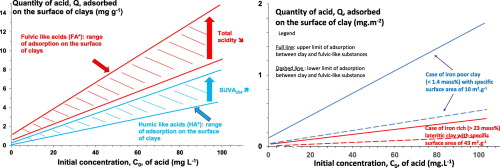当前位置:
X-MOL 学术
›
Appl. Clay. Sci.
›
论文详情
Our official English website, www.x-mol.net, welcomes your
feedback! (Note: you will need to create a separate account there.)
Adsorption of fulvic and humic like acids on surfaces of clays: Relation with SUVA index and acidity
Applied Clay Science ( IF 5.3 ) Pub Date : 2018-03-01 , DOI: 10.1016/j.clay.2017.12.036 Hervé Gouré-Doubi , Céline Martias , Agnès Smith , Nicolas Villandier , Vincent Sol , Vincent Gloaguen , Geneviève Feuillade
Applied Clay Science ( IF 5.3 ) Pub Date : 2018-03-01 , DOI: 10.1016/j.clay.2017.12.036 Hervé Gouré-Doubi , Céline Martias , Agnès Smith , Nicolas Villandier , Vincent Sol , Vincent Gloaguen , Geneviève Feuillade

|
Abstract In the context of sustainable development, economic and environmental issues encourage the valorization of local materials such as clay and agro-industrial waste. One of the major problems nowadays is the management of municipal waste. The degradation of this waste produces leachate rich in humic-like substances which can be valued for the consolidation of earth bricks. The characterization of the interaction between humic-like substances with clay minerals could provide a better understanding of the consolidation mechanism. In this respect, the adsorption behavior of fulvic and humic like acids on surfaces of distinctive raw clays has been studied. Five types of products were tested: green waste extract, municipal solid waste extract, two commercial products and one product synthetised from xylose. The quantities of fulvic acids adsorbed by the surfaces of raw clays (expressed in mg per g of clay) are greater than the quantities of humic acids. A raw clay with a large specific surface area and a large amount of iron compounds adsorbs a higher quantity (expressed in mg per g of clay) of fulvic acid than a raw clay, rich in kaolinite, containing less iron compounds and with a lower specific surface area. In alkaline conditions, the adsorbed quantities are lower than in alkaline conditions, and the surface area or the presence or iron compounds influence less the adsorption capacity than in acid conditions. It is interesting to note that if the adsorbed quantities are expressed in mg divided by the specific surface area of the clay, it appears that a kaolinite rich clay adsorbs more fulvic or humic like substances than a lateritic clay which is rich in iron oxides. Lastly, in acid (resp. alkaline) conditions, the parameter which governs the adsorption is the acidity (resp. the Specific Ultra-Violet Absorbance, SUVA index): the lower (resp. the higher) the parameter, the greater is the adsorption capacity. The interest in these adsorption reactions is the possibility to use these acids in the building sector for the manufacture of clay bricks at low temperature (compared to fired clay bricks).
中文翻译:

粘土表面富里酸和类腐殖酸的吸附:与 SUVA 指数和酸度的关系
摘要 在可持续发展的背景下,经济和环境问题促进了粘土和农业工业废物等当地材料的价值化。当今的主要问题之一是城市垃圾的管理。这种废物的降解产生富含腐殖质类物质的渗滤液,可用于固结土砖。腐殖质类物质与粘土矿物之间相互作用的表征可以更好地理解固结机制。在这方面,研究了富里酸和类腐殖酸在独特的生粘土表面上的吸附行为。测试了五种类型的产品:绿色废物提取物、城市固体废物提取物、两种商业产品和一种由木糖合成的产品。生粘土表面吸附的富里酸的量(以每克粘土的毫克数表示)大于腐殖酸的量。具有大比表面积和大量铁化合物的生粘土比富含高岭石、含有较少铁化合物和较低比表面积的生粘土吸附更多的富里酸(以毫克每克粘土表示)。表面积。在碱性条件下,吸附量低于在碱性条件下的吸附量,并且表面积或铁化合物的存在对吸附能力的影响比在酸性条件下要小。有趣的是,如果吸附量以 mg 除以粘土的比表面积表示,似乎富含高岭石的粘土比富含氧化铁的红土粘土吸附更多的富里石或腐殖质类物质。最后,在酸性(或碱性)条件下,控制吸附的参数是酸度(特别是紫外线吸收率,SUVA 指数):参数越低(越高),吸附越大容量。对这些吸附反应的兴趣是在建筑领域使用这些酸在低温下制造粘土砖(与烧制粘土砖相比)的可能性。
更新日期:2018-03-01
中文翻译:

粘土表面富里酸和类腐殖酸的吸附:与 SUVA 指数和酸度的关系
摘要 在可持续发展的背景下,经济和环境问题促进了粘土和农业工业废物等当地材料的价值化。当今的主要问题之一是城市垃圾的管理。这种废物的降解产生富含腐殖质类物质的渗滤液,可用于固结土砖。腐殖质类物质与粘土矿物之间相互作用的表征可以更好地理解固结机制。在这方面,研究了富里酸和类腐殖酸在独特的生粘土表面上的吸附行为。测试了五种类型的产品:绿色废物提取物、城市固体废物提取物、两种商业产品和一种由木糖合成的产品。生粘土表面吸附的富里酸的量(以每克粘土的毫克数表示)大于腐殖酸的量。具有大比表面积和大量铁化合物的生粘土比富含高岭石、含有较少铁化合物和较低比表面积的生粘土吸附更多的富里酸(以毫克每克粘土表示)。表面积。在碱性条件下,吸附量低于在碱性条件下的吸附量,并且表面积或铁化合物的存在对吸附能力的影响比在酸性条件下要小。有趣的是,如果吸附量以 mg 除以粘土的比表面积表示,似乎富含高岭石的粘土比富含氧化铁的红土粘土吸附更多的富里石或腐殖质类物质。最后,在酸性(或碱性)条件下,控制吸附的参数是酸度(特别是紫外线吸收率,SUVA 指数):参数越低(越高),吸附越大容量。对这些吸附反应的兴趣是在建筑领域使用这些酸在低温下制造粘土砖(与烧制粘土砖相比)的可能性。











































 京公网安备 11010802027423号
京公网安备 11010802027423号